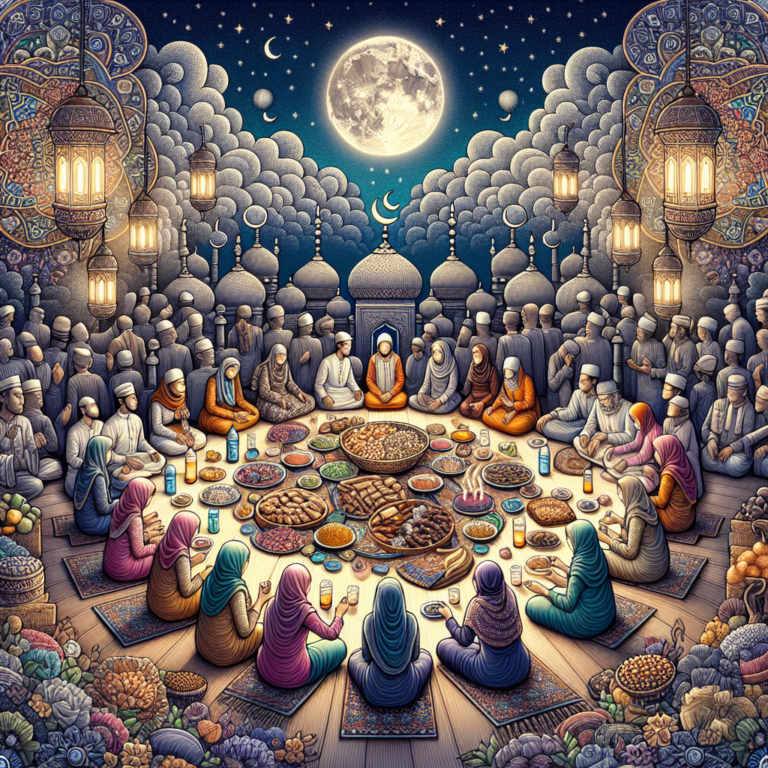Fasting and Feasting: The Cultural Significance of Ramadan Meals
Ramadan, the ninth month of the Islamic lunar calendar, holds profound spiritual significance for Muslims worldwide. It is a time of reflection, prayer, and fasting, where devotees abstain from food, drink, and other physical needs from dawn until sunset. Yet, Ramadan is not merely about fasting; it is equally a time of feasting. The iftar, the meal to break the fast, and suhoor, the pre-dawn meal, are culturally rich and deeply meaningful. These meals provide an opportunity for communal gathering, cultural expression, and spiritual reflection, underscoring the holistic nature of Islamic worship during this sacred month.
The Spiritual Rhythm of Ramadan
Fasting during Ramadan, or sawm, is one of the Five Pillars of Islam, signifying its compulsory status and deep importance. The act of fasting is intended to purify the soul, develop self-discipline, and cultivate empathy for the less fortunate. As the sun sets, the fast is broken with dates and water, emulating the tradition of the Prophet Muhammad. This practice is followed by the iftar meal, a vital part of the Ramadan experience, characterized by a variety of dishes that celebrate the essence of community and culture.
Iftar: A Celebration of Communal Harmony
Iftar is more than just a meal; it is a communal event that brings together families, friends, and strangers alike. It is common for mosques and community centers to host iftar dinners open to the public, fostering a spirit of inclusivity and brotherhood. The meal often begins with the eating of dates, inspired by the Prophet Muhammad, and is followed by a spread of regional specialties that vary by country and culture.
In the Middle East, iftar tables are often adorned with dishes such as hummus, falafel, and fattoush. In South Asia, one might find samosas, pakoras, and a variety of curries. Each dish reflects the culinary heritage of the community, connecting participants to their cultural roots while they share the joy of breaking their fast together.
Suhoor: The Pre-Dawn Nourishment
Suhoor, the early morning meal consumed before the fast begins at dawn, provides the energy and sustenance needed to endure the day’s fast. Unlike the celebratory nature of iftar, suhoor is often a quieter affair. Families rise in the pre-dawn hours to prepare and share this meal, which usually consists of nutritious, energy-giving foods such as eggs, yogurt, fruits, and bread.
Just as with iftar, suhoor varies widely by region. In Turkey, for example, suhoor might include börek (a savory pastry) and cheese, while in Indonesia, it could feature nasi goreng (fried rice) and tropical fruits. Despite being a more subdued event compared to iftar, suhoor embodies the same principles of unity and cultural diversity.
The Cultural Tapestry of Ramadan Meals
The diversity of foods consumed during iftar and suhoor highlights the rich cultural tapestry within the Muslim world. These meals are more than just sustenance; they are an expression of cultural identity, family tradition, and communal unity. Every region brings its unique flavors and traditions to the table, creating a mosaic of culinary practices that enrich the Ramadan experience for Muslims globally.
For instance, in Morocco, the iftar table might include harira, a spiced tomato and lentil soup, accompanied by chebakia, a sweet sesame cookie. In Iran, iftar could feature aush reshteh, a hearty noodle soup. These variations are a testament to the adaptability and inclusivity of Islamic practices, where the essence of fasting and feasting transcends geographical boundaries.
Conclusion: A Time of Reflection and Unity
Ramadan is a time of spiritual reflection and communal bonding. The dual practices of fasting and feasting are intertwined, each enhancing the significance of the other. Through the discipline of fasting, Muslims cultivate a sense of spiritual clarity and empathy. Through the joy of feasting, they celebrate fellowship, culture, and tradition.
The meals of Ramadan, both iftar and suhoor, serve as powerful symbols of unity and cultural diversity, demonstrating how food can be a universal language of connection. As families and communities come together to share these special meals, they reinforce the values of compassion, gratitude, and togetherness that lie at the heart of Ramadan.


